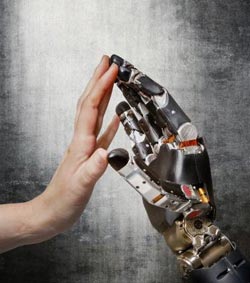A blueprint for restoring touch with a prosthetic hand

New research at the University of Chicago is laying the groundwork for touch-sensitive prosthetic limbs that one day could convey real-time sensory information to amputees via a direct interface with the brain.<br><br>Credit: PNAS, 2013<br>
The research, published early online in the Proceedings of the National Academy of Sciences, marks an important step toward new technology that, if implemented successfully, would increase the dexterity and clinical viability of robotic prosthetic limbs.
“To restore sensory motor function of an arm, you not only have to replace the motor signals that the brain sends to the arm to move it around, but you also have to replace the sensory signals that the arm sends back to the brain,” said the study's senior author, Sliman Bensmaia, PhD, assistant professor in the Department of Organismal Biology and Anatomy at the University of Chicago. “We think the key is to invoke what we know about how the brain of the intact organism processes sensory information, and then try to reproduce these patterns of neural activity through stimulation of the brain.”
Bensmaia's research is part of Revolutionizing Prosthetics, a multi-year Defense Advanced Research Projects Agency (DARPA) project that seeks to create a modular, artificial upper limb that will restore natural motor control and sensation in amputees. Managed by the Johns Hopkins University Applied Physics Laboratory, the project has brought together an interdisciplinary team of experts from academic institutions, government agencies and private companies.
Bensmaia and his colleagues at the University of Chicago are working specifically on the sensory aspects of these limbs. In a series of experiments with monkeys, whose sensory systems closely resemble those of humans, they indentified patterns of neural activity that occur during natural object manipulation and then successfully induced these patterns through artificial means.
The first set of experiments focused on contact location, or sensing where the skin has been touched. The animals were trained to identify several patterns of physical contact with their fingers. Researchers then connected electrodes to areas of the brain corresponding to each finger and replaced physical touches with electrical stimuli delivered to the appropriate areas of the brain. The result: The animals responded the same way to artificial stimulation as they did to physical contact.
Next the researchers focused on the sensation of pressure. In this case, they developed an algorithm to generate the appropriate amount of electrical current to elicit a sensation of pressure. Again, the animals' response was the same whether the stimuli were felt through their fingers or through artificial means.
Finally, Bensmaia and his colleagues studied the sensation of contact events. When the hand first touches or releases an object, it produces a burst of activity in the brain. Again, the researchers established that these bursts of brain activity can be mimicked through electrical stimulation.
The result of these experiments is a set of instructions that can be incorporated into a robotic prosthetic arm to provide sensory feedback to the brain through a neural interface. Bensmaia believes such feedback will bring these devices closer to being tested in human clinical trials.
“The algorithms to decipher motor signals have come quite a long way, where you can now control arms with seven degrees of freedom. It's very sophisticated. But I think there's a strong argument to be made that they will not be clinically viable until the sensory feedback is incorporated,” Bensmaia said. “When it is, the functionality of these limbs will increase substantially.”
The Defense Advanced Research Projects Agency, National Science Foundation and National Institutes of Health funded this study. Additional authors include Gregg Tabot, John Dammann, Joshua Berg and Jessica Boback from the University of Chicago; and Francesco Tenore and R. Jacob Vogelstein from the Johns Hopkins University Applied Physics Laboratory.
About the University of Chicago Medicine
The University of Chicago Medicine and its Comer Children's Hospital rank among the best in the country, most notably for cancer treatment, according to U.S. News & World Report's survey of the nation's hospitals. The University of Chicago's Pritzker School of Medicine has been named one of the Top 10 medical schools in the nation, by U.S. News' “Best Graduate Schools” survey. University of Chicago physician-scientists performed the first organ transplant and the first bone marrow transplant in animal models, the first successful living-donor liver transplant, the first hormone therapy for cancer and the first successful application of cancer chemotherapy. Its researchers discovered REM sleep and were the first to describe several of the sleep stages. Twelve of the Nobel Prize winners have been affiliated with the University of Chicago Medicine.
Visit our research blog at sciencelife.uchospitals.edu and our newsroom at uchospitals.edu/news.
Twitter: @UChicagoMed
Facebook: Facebook.com/UChicagoMed
Media Contact
More Information:
http://www.uchospitals.eduAll latest news from the category: Information Technology
Here you can find a summary of innovations in the fields of information and data processing and up-to-date developments on IT equipment and hardware.
This area covers topics such as IT services, IT architectures, IT management and telecommunications.
Newest articles

Silicon Carbide Innovation Alliance to drive industrial-scale semiconductor work
Known for its ability to withstand extreme environments and high voltages, silicon carbide (SiC) is a semiconducting material made up of silicon and carbon atoms arranged into crystals that is…

New SPECT/CT technique shows impressive biomarker identification
…offers increased access for prostate cancer patients. A novel SPECT/CT acquisition method can accurately detect radiopharmaceutical biodistribution in a convenient manner for prostate cancer patients, opening the door for more…

How 3D printers can give robots a soft touch
Soft skin coverings and touch sensors have emerged as a promising feature for robots that are both safer and more intuitive for human interaction, but they are expensive and difficult…





















